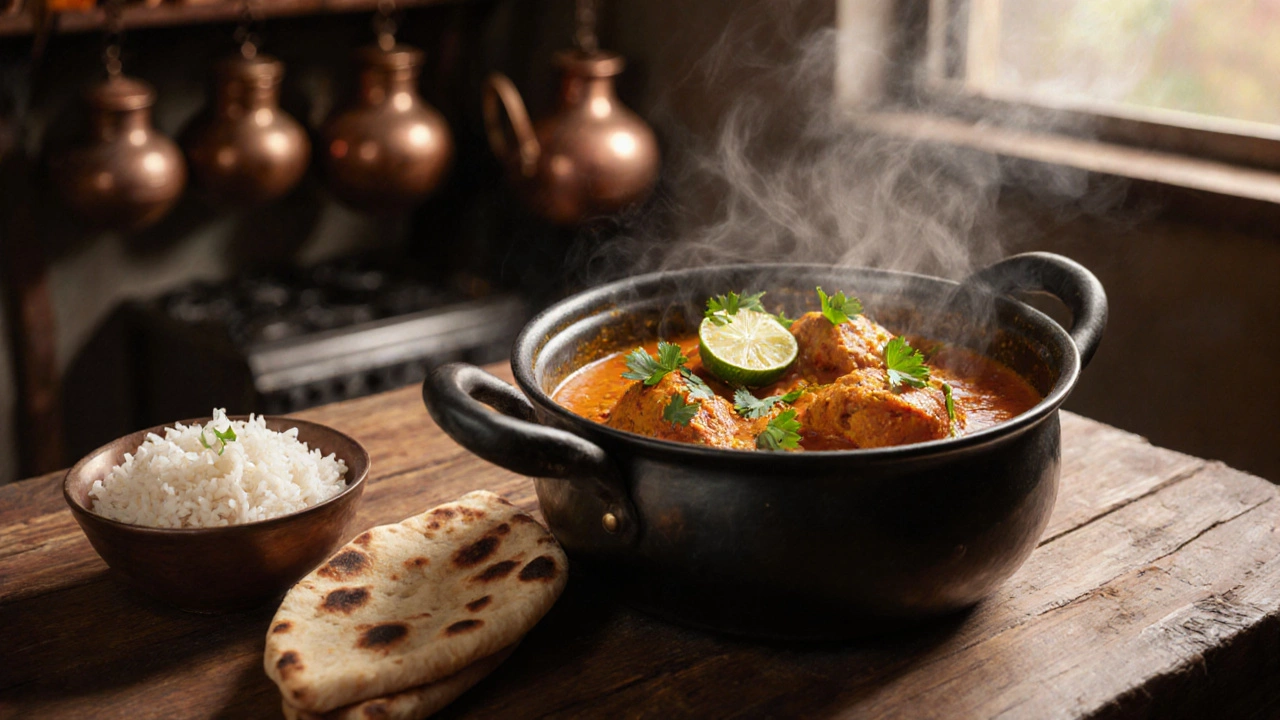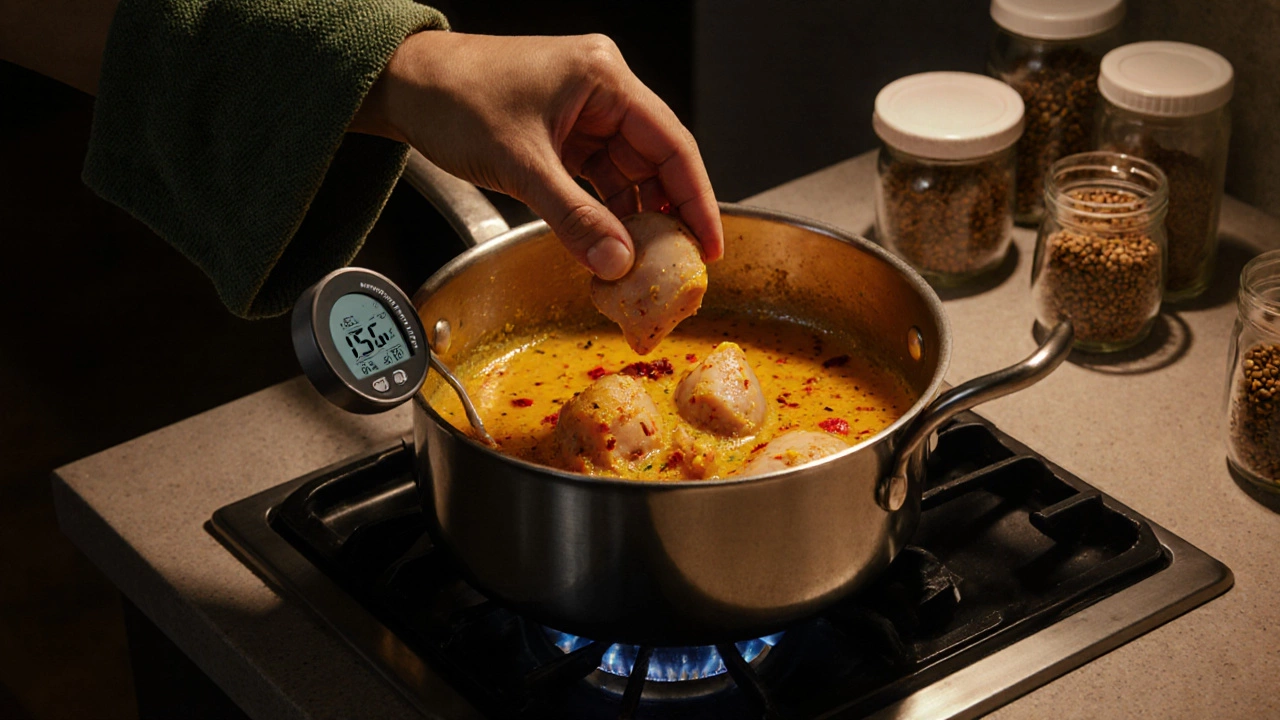Chicken Curry Safety Temperature Checker
Safety Guide
According to USDA guidelines, raw chicken must reach an internal temperature of 165°F (74°C) to be safe for consumption. This tool helps you verify if your curry has achieved this critical temperature.
Temperature Assessment
Ever wondered if you can toss raw chicken straight into a bubbling pot of curry and let it cook together? The short answer is yes-provided you handle the meat correctly and keep the heat steady. Below you’ll find the safety facts, step‑by‑step method, and common pitfalls so you can enjoy a tasty raw chicken curry without worrying about food‑borne illness.
Quick Takeaways
- Raw chicken is poultry that must reach an internal temperature of 165°F (74°C) to be safe can be added directly to a curry.
- Maintain a steady simmer (around 180‑190°F / 82‑88°C) for the whole cooking period.
- Marinate for at least 30minutes to boost flavor and reduce cooking time.
- Use a food‑safe thermometer to verify doneness.
- Avoid cross‑contamination by cleaning all surfaces and utensils.
Understanding Raw Chicken in Curry
When you hear "raw chicken," think of raw chicken uncooked poultry that may carry bacteria such as Salmonella or Campylobacter. Those microbes are killed at 165°F (74°C), which is the temperature recommended by the USDA and many health agencies. Adding the meat directly to a curry a sauce or gravy flavored with spices, aromatics, and often a liquid base like broth or coconut milk works because the liquid quickly brings the meat up to a safe temperature while infusing it with flavor.
Key to success is keeping the pot at a cooking temperature the heat level at which food is cooked, usually measured in Fahrenheit or Celsius that both cooks the chicken evenly and preserves the curry’s aromatic profile. Too low and you risk under‑cooked meat; too high and the sauce may scorch, turning bitter.
Safe Cooking Temperatures Explained
The devil is in the details when it comes to food safety practices that prevent foodborne illness, including proper handling, cooking, and storage. Here’s a quick rule‑of‑thumb:
- Heat the curry base until it reaches a rolling boil (212°F / 100°C).
- Reduce to a gentle simmer (180‑190°F / 82‑88°C) before adding the chicken.
- Stir occasionally to distribute heat evenly.
- After about 15‑20minutes, insert a digital thermometer into the thickest piece. When it reads 165°F (74°C), the chicken is safe.
Why a simmer and not a hard boil? A steady simmer cooks the meat through without breaking down the delicate spices. It also reduces the risk of bacterial contamination the presence of harmful microbes that can cause illness if not destroyed by heat on the surface of the meat.
The Role of Marination
Marinating raw chicken before it meets the curry does two things: it adds depth of flavor and it can shorten the time needed to reach safe temperature. A simple blend of yogurt, lemon juice, ginger‑garlic paste, and a pinch of salt creates an acidic environment that begins to break down muscle fibers.
Even a 30‑minute soak helps the meat retain moisture, which means less chance of it drying out during the simmer. If you’re pressed for time, skip the marination and add a splash of the same yogurt mix directly into the sauce after the chicken is half‑cooked.
How to Build a Flavorful Curry with Raw Chicken
Follow these steps for a reliable, tasty result:
- Prep the aromatics. Heat 2tablespoons of oil in a heavy‑bottomed pot. Add 1tsp cumin seeds, 1tsp mustard seeds, and let them pop.
- Sauté onions. Add 1‑large finely chopped onion; cook until golden. This develops sweetness and reduces bitterness.
- Introduce spices. Stir in 2tsp ground coriander, 1tsp turmeric, 1tsp garam masala, and ½tsp chili powder. Indian spices a blend of dried herbs and seeds that give curry its characteristic aroma and heat should toast lightly for 30seconds-watch closely to avoid burning.
- Add liquid. Pour in 1cup diced tomatoes (or canned) and 1cup coconut milk or broth. Bring to a boil, then lower to a simmer a gentle, steady bubbling where small bubbles rise slowly to the surface.
- Drop in the raw chicken. Cut the chicken into bite‑size pieces (about 1‑inch). Add them directly; the heat will start cooking immediately.
- Season and finish. After 10 minutes, check for doneness. Once the thermometer reads 165°F (74°C), stir in a handful of fresh cilantro and a squeeze of lime. Serve hot with rice or naan.
Tip: If you prefer a thicker gravy, mash a few of the softened tomatoes against the side of the pot before the final simmer.
Raw Chicken vs. Pre‑Cooked Chicken in Curry: Quick Comparison
| Aspect | Raw Chicken | Pre‑Cooked Chicken |
|---|---|---|
| Flavor Integration | Absorbs spices during cooking, richer taste | Less absorption, may feel separate |
| Safety | Requires careful temperature control | Already safe, only needs reheating |
| Cooking Time | 15‑20minutes to reach 165°F | 5‑7minutes to warm through |
| Texture | Tender if cooked properly, can dry if overcooked | Can become rubbery if over‑heated |
| Convenience | More steps, need thermometer | Quick and easy, especially for leftovers |
For most home cooks, raw chicken is the go‑to because it yields the most cohesive flavor. Just remember the safety checklist.

Common Mistakes & How to Avoid Them
- Adding chicken to a raging boil. The outer layer cooks too fast, sealing in juices but leaving the core under‑cooked. Keep the heat at a gentle simmer.
- Skipping the thermometer. Visual cues can be misleading. A digital probe is the only reliable way to hit 165°F.
- Over‑crowding the pot. Too many pieces lower the overall temperature, extending cooking time and risking uneven doneness. Cook in batches if needed.
- Using the same cutting board for raw chicken and veggies. This cross‑contamination is a major food safety practice that prevents the spread of harmful bacteria hazard. Always separate boards or thoroughly wash between uses.
- Neglecting to rest the curry. After the chicken reaches temperature, let the pot sit covered for 3‑5 minutes. Carry‑over heat finishes cooking and allows flavors to meld.
Troubleshooting
Problem: The chicken looks pink even after 20minutes.
Solution: Check the thermometer calibration. If it reads low, increase cooking time by 5minutes and verify again. Ensure the pot isn’t losing heat-cover with a lid.
Problem: The sauce turns bitter.
Solution: Bitter flavors often come from burnt spices. Keep the heat medium, stir constantly when toasting spices, and add a pinch of sugar or a splash of cream to balance.
Problem: The chicken becomes dry.
Solution: Reduce simmer time; use bone‑in pieces or add a tablespoon of butter at the end. Marinating with yogurt also helps retain moisture.
Next Steps: Elevate Your Curry Game
Now that you’ve mastered the basics, try experimenting with:
- Different cuts: thighs stay juicier than breast.
- Alternate acids: tamarind paste or mango puree for a tangy twist.
- Smoked paprika or chipotle for a smoky depth.
- Finishing with toasted nuts (cashews or almonds) for crunch.
Each tweak keeps the core safety principles intact while letting you customize the flavor profile.
Frequently Asked Questions
Can I add frozen raw chicken directly to a curry?
Yes, but you must increase the cooking time by about 5‑7 minutes and ensure the internal temperature still hits 165°F. Thawing first gives more even cooking and reduces the risk of the sauce cooling down too much.
Do I need to pre‑brown the chicken before simmering?
Pre‑browning isn’t required for safety, but it adds a caramelized flavor and reduces the chance of a grayish broth. If you choose to brown, do it quickly on high heat, then deglaze with a splash of broth before adding the rest of the sauce.
How long can I store leftover chicken curry?
Cool the curry within two hours, then refrigerate in an airtight container. It stays good for 3‑4 days. Reheat to a rolling boil before serving to kill any bacteria that might have grown.
Is it safe to use the same pot for chicken and sauce without washing?
If the chicken is cooked thoroughly in the pot, the heat will kill most bacteria. However, to avoid cross‑contamination from raw juices before cooking, it’s best to wash the pot or at least the sides where raw meat touched.
What’s the best way to check doneness without a thermometer?
A cut piece should be opaque all the way through, and the juices should run clear. The meat should not feel rubbery. Still, a thermometer is the most reliable method, especially for home cooks who prioritize safety.
